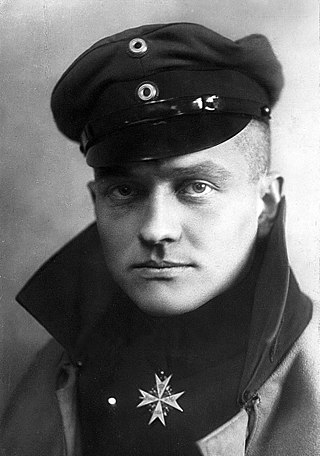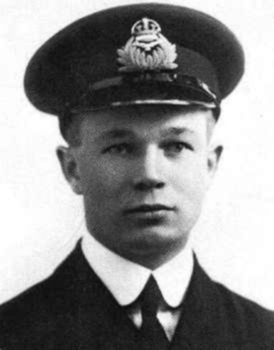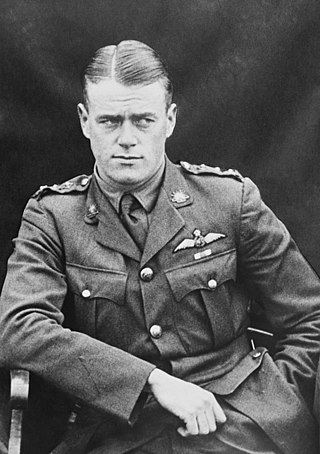Related Research Articles

Manfred Albrecht Freiherr von Richthofen, known in English as Baron von Richthofen or the Red Baron, was a fighter pilot with the German Air Force during World War I. He is considered the ace-of-aces of the war, being officially credited with 80 air combat victories.

A flying ace, fighter ace or air ace is a military aviator credited with shooting down five or more enemy aircraft during aerial combat. The exact number of aerial victories required to officially qualify as an ace is varied, but is usually considered to be five or more.

World War I was the first major conflict involving the large-scale use of aircraft. Tethered observation balloons had already been employed in several wars and would be used extensively for artillery spotting. Germany employed Zeppelins for reconnaissance over the North Sea and Baltic and also for strategic bombing raids over Britain and the Eastern Front.

Arthur Roy Brown, was a Canadian flying ace of the First World War, credited with ten aerial victories. The Royal Air Force officially credited Brown with shooting down Manfred von Richthofen, the "Red Baron", although historians, doctors, and ballistics experts consider it all but certain that Richthofen was actually killed by a machine gunner firing from the ground.
Elwyn Roy King, DSO, DFC was a fighter ace in the Australian Flying Corps (AFC) during World War I. He achieved twenty-six victories in aerial combat, making him the fourth highest-scoring Australian pilot of the war, and second only to Harry Cobby in the AFC. A civil pilot and engineer between the wars, he served in the Royal Australian Air Force (RAAF) from 1939 until his death.
Cedric Ernest "Spike" Howell, was an Australian fighter pilot and flying ace of the First World War. Born in Adelaide, South Australia, he enlisted in the Australian Imperial Force in 1916 for service in the First World War and was posted to the 46th Battalion on the Western Front. In November 1916, he was accepted for a transfer to the Royal Flying Corps and was shipped to the United Kingdom for flight training. Graduating as a pilot, he was commissioned as a second lieutenant and posted to No. 45 Squadron RFC in France during October 1917; two months later the unit sailed to the Italian theatre.
Captain William Lancelot Jordan DSC & Bar, DFC was a South African World War I flying ace credited with 39 victories.
Joseph Stewart Temple Fall, was a Canadian aviator, military officer, and First World War flying ace credited with 36 aerial victories.

Samuel Marcus Kinkead DSO, DSC & Bar, DFC & Bar was a South African fighter ace with 33 victories during the First World War. He went on to serve in southern Russia and the Middle East postwar.
Lieutenant Carrick Stewart Paul DFC (5 February 1893–22 January 1919 was a World War I flying ace from New Zealand. He was credited with five aerial victories in Palestine between May and August 1918 when flying a Bristol F.2 Fighter.
Francis Ryan Smith, was an Australian flying ace of the First World War, credited with 16 aerial victories. Following the war, he studied engineering and worked in China, eventually starting his own aviation business. During the Second World War, Smith served in the Royal Australian Air Force, as a squadron leader.

Roy Cecil Phillipps, MC & Bar, DFC was an Australian fighter ace of World War I. He achieved fifteen victories in aerial combat, four of them in a single action on 12 June 1918. A grazier between the wars, he joined the Royal Australian Air Force (RAAF) in 1940 and was killed in a plane crash the following year.
Brigadier Charles Gordon Ross was a career soldier who served in both the Royal Air Force and the South African Air Force. He was a quadruple ace, being credited with 20 victories during World War I.
Captain Charles Stewart Touzeau Lavers BEM was a British World War I flying ace credited with nine aerial victories.
Geoffrey Herbert Hooper was an Australian World War I flying ace credited with eleven aerial victories, all against German fighter planes.
Captain Frank Clifton Gorringe was a British World War I flying ace credited with 14 aerial victories.
Captain Stanley Stanger was a World War I flying ace credited with 13 confirmed aerial victories scored on the Italian Front. He was also noted for his ingenious escape from being captured by the Austro-Hungarians.
Roby Lewis Manuel, with Bar, was an Australian flying ace of the First World War credited with 12 official aerial victories. He led the Anzac Day flyby in London in 1919. When World War II erupted, Manuel joined the Royal Australian Air Force and once again served his nation.

During World War I, the national air services involved developed their own methods of assessing and assigning credit for aerial victories.
Edgar Garfield Finlay, was an Australian flying ace of the First World War. He served with distinction in the Gallipoli Campaign as a noncommissioned officer in the Light Horse. After transferring to the Australian Flying Corps, he was commissioned and served as an aerial observer. In this role he was credited with eight aerial victories before training as a pilot.
References
- Cutlack, Frederic (1941). The Australian Flying Corps in the Western and Eastern Theatres of War, 1914–1918 (11th ed.). Sydney, New South Wales: Angus and Robertson.
- Newton, Dennis (1996). Australian Air Aces: Australian Fighter Pilots in Combat. Fyshwick, Australian Capital Territory: Aerospace Publications. ISBN 1-875671-25-0.
- Shores, Christopher F.; Franks, Norman L. R.; Guest, Russell (1990). Above the Trenches: A Complete Record of the Fighter Aces and Units of the British Empire Air Forces 1915–1920 (Print). Ontario, London: Fortress/Grub Street. ISBN 0-948817-19-4.